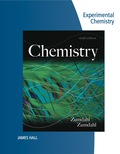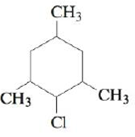
Lab Manual For Zumdahl/zumdahl's Chemistry, 9th
9th Edition
ISBN: 9781285692357
Author: Steven S. Zumdahl, Susan A. Zumdahl
Publisher: Cengage Learning
expand_more
expand_more
format_list_bulleted
Concept explainers
Textbook Question
Chapter 22, Problem 139CWP
Name each of the following cyclic
a. 
b. 
c. 
d. 
Expert Solution & Answer
Want to see the full answer?
Check out a sample textbook solution
Students have asked these similar questions
Choose the Lewis structure for the compound below:
H2CCHOCH2CH(CH3)2
HH
H
:d
H
H
H C.
Η
H
H
HH
H
H
H
H.
H
H
H
HH
H
H
H
H
H-
H
H
H
C-H
H
H
HHHH
Each of the highlighted carbon atoms
is connected to
hydrogen atoms.
く
Complete the reaction in the drawing area below by adding the major products to the right-hand side.
If there won't be any products, because nothing will happen under these reaction conditions, check the box under the drawing area
instead.
Note: if the products contain one or more pairs of enantiomers, don't worry about drawing each enantiomer with dash and wedge
bonds. Just draw one molecule to represent each pair of enantiomers, using line bonds at the chiral center.
More...
No reaction.
Explanation
Check
O
+
G
1. Na O Me
Click and drag to start
drawing a structure.
2. H
+
2025 McGraw Hill LLC. All Rights Reserved. Terms of Use | Privacy Center | Accessibility
000
Ar
P
Chapter 22 Solutions
Lab Manual For Zumdahl/zumdahl's Chemistry, 9th
Ch. 22 - What is a hydrocarbon? What is the difference...Ch. 22 - Prob. 2RQCh. 22 - What are aromatic hydrocarbons? Benzene exhibits...Ch. 22 - Summarize the nomenclature rules for alkanes,...Ch. 22 - What functional group distinguishes each of the...Ch. 22 - Distinguish between isomerism and resonance....Ch. 22 - Prob. 7RQCh. 22 - Prob. 8RQCh. 22 - Prob. 9RQCh. 22 - Prob. 10RQ
Ch. 22 - Prob. 11RQCh. 22 - Describe the structural differences between DNA...Ch. 22 - Prob. 1QCh. 22 - Prob. 2QCh. 22 - Prob. 3QCh. 22 - Prob. 4QCh. 22 - Prob. 5QCh. 22 - Prob. 6QCh. 22 - Prob. 7QCh. 22 - Give an example reaction that would yield the...Ch. 22 - Prob. 9QCh. 22 - Prob. 10QCh. 22 - Prob. 11QCh. 22 - Prob. 12QCh. 22 - Prob. 13ECh. 22 - Prob. 14ECh. 22 - Draw all the structural isomers for C8H18 that...Ch. 22 - Draw all the structural isomers for C8H18 that...Ch. 22 - Prob. 17ECh. 22 - Prob. 18ECh. 22 - Draw the structural formula for each of the...Ch. 22 - Prob. 20ECh. 22 - Prob. 21ECh. 22 - Name each of the following cyclic alkanes, and...Ch. 22 - Prob. 23ECh. 22 - Draw the structures for two examples of...Ch. 22 - Name each of the following alkenes. a. CH2 = CH ...Ch. 22 - Name each of the following alkenes or alkynes. a....Ch. 22 - Prob. 27ECh. 22 - Give the structure for each of the following. a....Ch. 22 - Prob. 29ECh. 22 - Cumene is the starting material for the industrial...Ch. 22 - Name each of the following. a. b. CH3CH2CH2CCl3 c....Ch. 22 - Prob. 32ECh. 22 - There is only one compound that is named...Ch. 22 - Prob. 34ECh. 22 - Prob. 35ECh. 22 - Prob. 36ECh. 22 - Draw all the structural isomers of C5H10. Ignore...Ch. 22 - Prob. 38ECh. 22 - Draw all the structural and geometrical (cistrans)...Ch. 22 - Draw all the structural and geometrical (cistrans)...Ch. 22 - Draw all structural and geometrical (cistrans)...Ch. 22 - Prob. 42ECh. 22 - Prob. 43ECh. 22 - Prob. 44ECh. 22 - If one hydrogen in a hydrocarbon is replaced by a...Ch. 22 - There are three isomers of dichlorobenzene, one of...Ch. 22 - Identify each of the following compounds as a...Ch. 22 - Prob. 48ECh. 22 - Mimosine is a natural product found in large...Ch. 22 - Minoxidil (C9H15N5O) is a compound produced by...Ch. 22 - For each of the following alcohols, give the...Ch. 22 - Prob. 52ECh. 22 - Prob. 53ECh. 22 - Prob. 54ECh. 22 - Prob. 55ECh. 22 - Prob. 56ECh. 22 - Prob. 57ECh. 22 - Prob. 58ECh. 22 - Prob. 59ECh. 22 - Prob. 60ECh. 22 - Prob. 61ECh. 22 - Prob. 62ECh. 22 - Prob. 63ECh. 22 - Prob. 64ECh. 22 - Prob. 65ECh. 22 - Prob. 66ECh. 22 - Prob. 67ECh. 22 - Prob. 68ECh. 22 - Prob. 69ECh. 22 - Prob. 70ECh. 22 - Prob. 71ECh. 22 - Prob. 72ECh. 22 - Super glue contains methyl cyanoacrylate, which...Ch. 22 - Prob. 74ECh. 22 - Prob. 75ECh. 22 - Prob. 76ECh. 22 - Prob. 77ECh. 22 - Prob. 78ECh. 22 - Prob. 79ECh. 22 - Prob. 80ECh. 22 - Prob. 81ECh. 22 - Prob. 82ECh. 22 - Prob. 83ECh. 22 - Prob. 84ECh. 22 - Aspartame, the artificial sweetener marketed under...Ch. 22 - Prob. 86ECh. 22 - Prob. 87ECh. 22 - Draw the structures of the tripeptides glyalaser...Ch. 22 - Prob. 89ECh. 22 - Prob. 90ECh. 22 - Give an example of amino acids that could give...Ch. 22 - What types of interactions can occur between the...Ch. 22 - Prob. 93ECh. 22 - Prob. 94ECh. 22 - Prob. 95ECh. 22 - Prob. 96ECh. 22 - Prob. 97ECh. 22 - Prob. 98ECh. 22 - Prob. 99ECh. 22 - Prob. 100ECh. 22 - Prob. 101ECh. 22 - Prob. 102ECh. 22 - Prob. 103ECh. 22 - Prob. 104ECh. 22 - Prob. 105ECh. 22 - Prob. 106ECh. 22 - Prob. 107ECh. 22 - Prob. 108ECh. 22 - The base sequences in mRNA that code for certain...Ch. 22 - Prob. 110ECh. 22 - Prob. 111AECh. 22 - Prob. 112AECh. 22 - Prob. 113AECh. 22 - Prob. 114AECh. 22 - Prob. 115AECh. 22 - Prob. 116AECh. 22 - Explain why methyl alcohol is soluble in water in...Ch. 22 - Prob. 118AECh. 22 - Prob. 119AECh. 22 - Prob. 120AECh. 22 - Prob. 121AECh. 22 - Prob. 122AECh. 22 - Prob. 123AECh. 22 - Prob. 124AECh. 22 - Prob. 125AECh. 22 - Prob. 126AECh. 22 - Prob. 127AECh. 22 - Prob. 128AECh. 22 - Prob. 129AECh. 22 - a. Use bond energies (see Table 3-3) to estimate H...Ch. 22 - Prob. 131AECh. 22 - Prob. 132AECh. 22 - All amino acids have at least two functional...Ch. 22 - Prob. 134AECh. 22 - Prob. 135AECh. 22 - In glycine, the carboxylic acid group has Ka = 4.3...Ch. 22 - Name each of the following alkanes. a....Ch. 22 - Prob. 138CWPCh. 22 - Name each of the following cyclic alkanes. a. b....Ch. 22 - Name each of the following alkenes and alkynes. a....Ch. 22 - a. Name each of the following alcohols. b. Name...Ch. 22 - Prob. 142CWPCh. 22 - Prob. 143CWPCh. 22 - Prob. 144CWPCh. 22 - Prob. 145CPCh. 22 - Prob. 146CPCh. 22 - Prob. 147CPCh. 22 - Consider a sample of a hydrocarbon at 0.959 atm...Ch. 22 - Prob. 149CPCh. 22 - Prob. 150CPCh. 22 - Prob. 151CPCh. 22 - Prob. 152CPCh. 22 - Prob. 153CPCh. 22 - Prob. 154CPCh. 22 - Prob. 155CPCh. 22 - Alcohols are very useful starting materials for...Ch. 22 - A chemical breathalyzer test works because ethanol...Ch. 22 - Estradiol is a female hormone with the following...Ch. 22 - Prob. 159IPCh. 22 - Prob. 160IPCh. 22 - Prob. 161MPCh. 22 - Prob. 162MP
Knowledge Booster
Learn more about
Need a deep-dive on the concept behind this application? Look no further. Learn more about this topic, chemistry and related others by exploring similar questions and additional content below.Similar questions
- Draw a tetramer of this alternating copolymer.arrow_forwardH I T H HH H -H C. H- Identify and select all structures below that represent a constitutional isomer(s) of the compound shown above. H- H CIH H H H HHHH H H 0 ·H H– 冊 CH CHI HH C- H- H H- H H A. H H C H H- -H HH H B. H- -H D. H H H H • H -H E. -H H H HICH T HHH F. H-arrow_forwardPolylactic acid (shown below) is a biodegradable polymer used for food packaging. Identify the monomer(s) used in the production of this polymer using a condensation process.arrow_forward
- Draw the product of the reaction shown below. Ignore small byproducts that would evaporate pleasearrow_forwardPoly(ethylene adipate) is a biodegradable polyester (shown below). Identify the type of polymerization process used in the production of this polymer.arrow_forwardPolymers may be composed of thousands of monomers. draw two repeat units(dimer) of the polymer formed in this reaction. assume there are hydrogen atoms on the two ends of the dimer. ignore inorganic byproducts pleasearrow_forward
- Draw the product of the reaction shown below. Use a dash or wedge bond to indicate stereochemistry of substituents on asymmetric centers, Ignore inorganic byproductsarrow_forwardDraw the product of this reaction please. Ignore inorganic byproductsarrow_forwardOne of the pi molecular orbitals of 1,3-butadiene (CH2=CHCH=CH2) is shown below. Please identify the number of nodal planes perpendicular to the bonding axisarrow_forward
- Draw the monomers required to synthesize this condensation polymer please.arrow_forwardProvide the correct systematic name for the compound shown here. Please take into account the keyboard options belowarrow_forwardcurved arrows are used to illustrate the flow of electrons. using the provided starting and product structures, draw the curved electron-pushing arrows for the following reaction or mechanistic step(s)arrow_forward
arrow_back_ios
SEE MORE QUESTIONS
arrow_forward_ios
Recommended textbooks for you
 World of Chemistry, 3rd editionChemistryISBN:9781133109655Author:Steven S. Zumdahl, Susan L. Zumdahl, Donald J. DeCostePublisher:Brooks / Cole / Cengage Learning
World of Chemistry, 3rd editionChemistryISBN:9781133109655Author:Steven S. Zumdahl, Susan L. Zumdahl, Donald J. DeCostePublisher:Brooks / Cole / Cengage Learning Introductory Chemistry: An Active Learning Approa...ChemistryISBN:9781305079250Author:Mark S. Cracolice, Ed PetersPublisher:Cengage Learning
Introductory Chemistry: An Active Learning Approa...ChemistryISBN:9781305079250Author:Mark S. Cracolice, Ed PetersPublisher:Cengage Learning Chemistry: Principles and ReactionsChemistryISBN:9781305079373Author:William L. Masterton, Cecile N. HurleyPublisher:Cengage Learning
Chemistry: Principles and ReactionsChemistryISBN:9781305079373Author:William L. Masterton, Cecile N. HurleyPublisher:Cengage Learning World of ChemistryChemistryISBN:9780618562763Author:Steven S. ZumdahlPublisher:Houghton Mifflin College DivChemistry: Matter and ChangeChemistryISBN:9780078746376Author:Dinah Zike, Laurel Dingrando, Nicholas Hainen, Cheryl WistromPublisher:Glencoe/McGraw-Hill School Pub Co
World of ChemistryChemistryISBN:9780618562763Author:Steven S. ZumdahlPublisher:Houghton Mifflin College DivChemistry: Matter and ChangeChemistryISBN:9780078746376Author:Dinah Zike, Laurel Dingrando, Nicholas Hainen, Cheryl WistromPublisher:Glencoe/McGraw-Hill School Pub Co

World of Chemistry, 3rd edition
Chemistry
ISBN:9781133109655
Author:Steven S. Zumdahl, Susan L. Zumdahl, Donald J. DeCoste
Publisher:Brooks / Cole / Cengage Learning

Introductory Chemistry: An Active Learning Approa...
Chemistry
ISBN:9781305079250
Author:Mark S. Cracolice, Ed Peters
Publisher:Cengage Learning

Chemistry: Principles and Reactions
Chemistry
ISBN:9781305079373
Author:William L. Masterton, Cecile N. Hurley
Publisher:Cengage Learning

World of Chemistry
Chemistry
ISBN:9780618562763
Author:Steven S. Zumdahl
Publisher:Houghton Mifflin College Div

Chemistry: Matter and Change
Chemistry
ISBN:9780078746376
Author:Dinah Zike, Laurel Dingrando, Nicholas Hainen, Cheryl Wistrom
Publisher:Glencoe/McGraw-Hill School Pub Co

Chapter 4 Alkanes and Cycloalkanes Lesson 2; Author: Linda Hanson;https://www.youtube.com/watch?v=AL_CM_Btef4;License: Standard YouTube License, CC-BY
Chapter 4 Alkanes and Cycloalkanes Lesson 1; Author: Linda Hanson;https://www.youtube.com/watch?v=PPIa6EHJMJw;License: Standard Youtube License